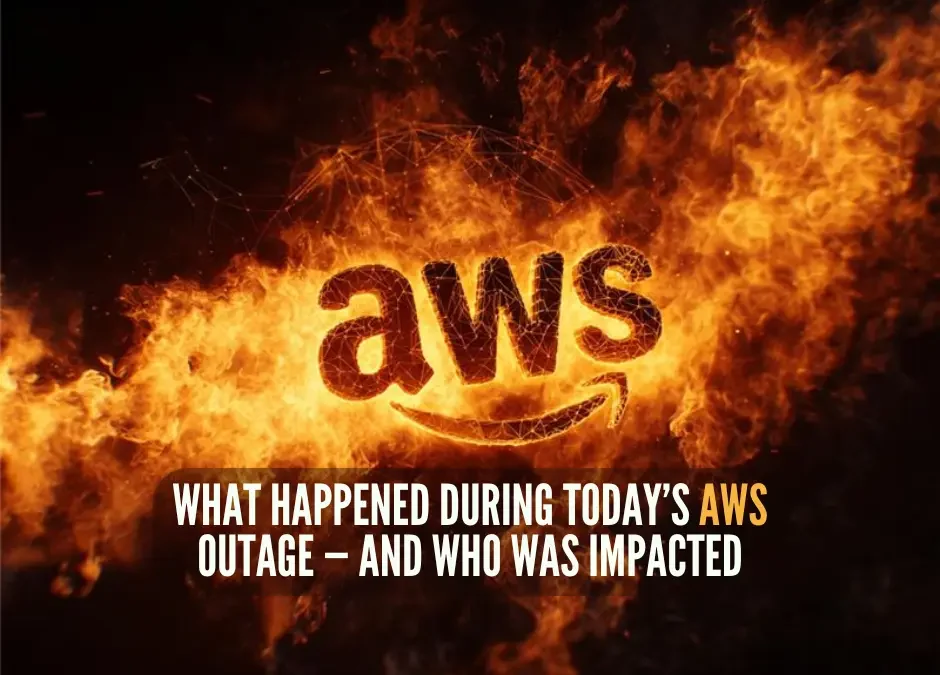On October 20, 2025, Amazon Web Services (AWS) experienced a major outage originating in its US-East-1 (Northern Virginia) region. The disruption led to widespread errors, timeouts, and service interruptions across several AWS products, including DynamoDB, EC2, and Lambda.
The outage caused many popular websites and applications—ranging from streaming and gaming platforms to payment and smart-home services—to become partially or fully unavailable. AWS identified the issue as a DNS resolution problem affecting the DynamoDB endpoint in the affected region and began deploying mitigation steps while monitoring recovery.
(Source: AWS Status Page, Reuters, TechRadar)
Timeline and Recovery
- Early reports began appearing on outage trackers around 2:40 a.m. ET (6:40 a.m. UTC). Users noticed failures across major consumer apps as the issue propagated.
(Source: TechRadar) - AWS’s official updates confirmed that DNS resolution issues in the us-east-1 region caused elevated error rates for multiple services. The company said most systems were partially restored within several hours, though some residual issues (such as delayed instance launches) persisted during recovery.
(Source: AWS Status Page, Reuters) - By midday, AWS reported that “most requests are now succeeding,” with recovery progressing and backlogs clearing gradually.
(Source: Datacenter Dynamics, Reuters)
Useful Resources for Updates
- AWS Service Health Dashboard — official, real-time status updates.
- AWS Incident Summary — detailed mitigation timeline and service notes.
- Reuters Coverage — business-focused summary of the event.
- The Guardian Report — broader overview of how the outage affected users and organizations.
- Downdetector — real-time reports of service disruptions across apps.
Why This Matters: The Fragile Nature of Modern Tech
Today’s outage is a stark reminder of how dependent the modern internet is on a handful of cloud providers. When a major region or a key service like DNS resolution fails, the ripple effects reach across the digital economy.
Even unrelated apps can experience downtime because they rely on shared cloud infrastructure for databases, APIs, or authentication.
This incident highlights two key lessons:
- Relying on a single cloud region or provider increases risk.
- Resilient design—using multi-region deployments, cached fallbacks, and redundancy—is essential.
Industry analysts noted that such outages raise ongoing discussions about systemic cloud risk, though there is no public indication of new regulatory action directly tied to this event.
(Source: The Guardian, Datacenter Dynamics)
How This Could Impact You
- Consumers: You may have noticed outages in apps such as Snapchat, Ring, Venmo, Fortnite, and Alexa, which rely on AWS infrastructure. These disruptions affected communication, payments, and smart-home functions.
(Source: Reuters, TechRadar) - Small businesses and online sellers: Services that depend on AWS for checkout systems, notifications, or APIs may have faced temporary failures, leading to missed transactions or frustrated customers.
(Source: LA Times, The Guardian) - Students and remote workers: Educational and collaboration platforms hosted on AWS could have been temporarily inaccessible, disrupting online meetings and assignments.
(Source: TechRadar) - Financial and public services: Some UK banking and government websites, including Lloyds Bank and HM Revenue & Customs, reported brief interruptions during the outage.
(Source: The Guardian) - Developers and IT teams: Technical staff experienced spikes in error logs, delayed instance launches, and support requests. Post-incident reviews often involve verifying service stability, clearing backlogs, and testing failover systems.
(Source: AWS Status Page, Datacenter Dynamics)
Practical Steps During an AWS Outage
- Check the AWS Service Health Dashboard for real-time updates.
- If you manage cloud systems, monitor for failed API calls and route traffic to a backup region if possible.
- As a consumer, use alternative apps or offline methods for critical tasks (payments, communication) until services stabilize.
FAQ — Quick Answers
Q: What caused today’s AWS outage?
A: AWS confirmed that the disruption stemmed from DNS resolution issues affecting DynamoDB endpoints in the US-East-1 region, which cascaded into failures across other services.
(Source: AWS Status Page, TechRadar)
Q: Which apps and services were affected?
A: Major apps including Snapchat, Ring, Venmo, Fortnite, and Alexa, along with some financial and government sites, experienced temporary disruptions.
(Source: Reuters, The Guardian)
Q: Was any data lost?
A: No data loss has been reported. AWS described the incident as a service availability issue, not a data-integrity problem.
(Source: AWS Status Page, Al Jazeera)
Q: How long did it take to recover?
A: Partial recovery began within several hours, and full restoration occurred later the same day, though some dependent services experienced delays.
(Source: Reuters, Datacenter Dynamics)
Q: What can businesses learn from this?
A: The event underscores the importance of multi-region redundancy, disaster recovery planning, and transparent communication with customers during outages.
(Source: The Guardian)
Q: Where can I find live updates?
A: Follow the AWS Service Health Dashboard or the AWS Status Page, and monitor trusted news outlets such as Reuters and The Guardian for ongoing analysis.
Want to make sure your business is insulated from these sorts of tech disasters? Get an IT Assessment Today and make sure your business is secure!


Recent Comments